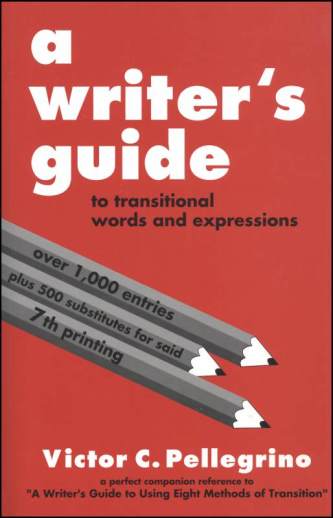We use cookies to make your experience better. To comply with the new e-Privacy directive, we need to ask for your consent to set the cookies. Learn more.
Writer's Guide to Transitional Words / Phrases
One of the big things that keeps students from producing fluid and powerful writing is the lack of originality and effectiveness in transitions. This guidebook is designed to help writers connect ideas and create a smooth flow of sentences and paragraphs. It is conveniently divided and thumb-indexed into 15 categories, each containing one page with a helpful list of transitional words to use for that method of transitioning. Categories are: to indicate time order (presently, afterward, etc.); to indicate how or when something occurs in time (suddenly, always, etc.); to indicate sequence (first, next, etc.); to repeat (all in all, in short, etc.); to provide an example (for instance, to clarify, etc.), to concede (granted, albeit, etc.); to conclude (in conclusion, therefore, etc.); to add a point (moreover, plus, etc.); to compare (similarity, in the same way, etc.); to contrast (and yet, however, etc.); to indicate cause and effect (incidentally, therefore, etc.); to divide or classify (first, to split, etc.); to indicate spatial arrangement (in, adjoining, etc.); to emphasize or intensify (above all, to stress, etc.); and to connect clauses (and, as though, etc.). A page full of substitutes for the word "said" is also provided, allowing students to vary the way they express that word as well. These word lists (with dozens of words per category) are a great reference for students who tend to use the same words and expressions in their writing. While this book is simply a reference with lists of transitional words (which is great to use independently), it also works with A Writer's Guide to Using 8 Methods of Transition, a companion guide that teaches how to use all the methods of transition. With 1,000 entries in all and 500 substitutions for "said", this handy guide is a valuable reference. 20 pgs, pb. ~ Rachel
These materials are resources for the teacher or student, offering instruction and ideas for teaching children to write but not providing "in-book" assignments/practice.
| Product Format: | Softcover Book |
|---|---|
| Brand: | Maui Arthoughts Company |
| Author: | Victor C. Pellegrino |
| Grades: | 7-12 |
| ISBN: | 9780945045021 |
| Length in Inches: | 9 |
| Width in Inches: | 6 |
| Height in Inches: | 0.25 |
| Weight in Pounds: | 0.3 |

